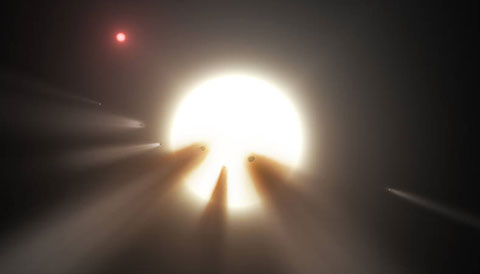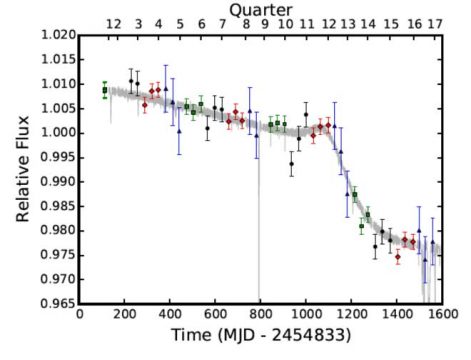Astronomy - Tabby’s Star: Weird Star Gets Weirder
A new study on KIC 8462852, the star of alien megastructure fame, finds yearlong trends that effectively rule out the one working theory astronomers had to explain this strange star.

Tabby's star, also known as KIC 8462485, showed a strange series of dips in its lightcurve that astronomers thought they could explain with a swarm of comets breaking apart in the star's gravity. A new study rules out that idea, putting astronomers back at square one.NASA / JPL-Caltech
Tabby’s Star, or KIC 8462852 as it’s more formally known, made headlines last year when Tabetha Boyajian, then a postdoc at Yale University, announced the discovery of this system’s strange patterns in brightness. The star’s weird dips have defied explanation and even prompted theories about extraterrestrial life.
The story keeps getting better: as astronomers called for more data and SETI searched for alien radio signals, archival investigations for historical context stirred up controversy on the star’s longterm trends. Now, with the release of a new study last week that finds that the star has long been fading, it looks like Tabby’s star is even weirder than we knew.
The Curious Case of KIC 8462852
The star was one of more than 150,000 that Kepler monitored during its original four-year mission. While computer algorithms were busy picking out planets by the thousands around other stars, humans volunteering in the Planet Hunters citizen science project spotted strange dips in brightness around a singular star. Typical planetary transits dip by a few percent (or usually far less) for a few hours, but as we shared with our readers last year, this star would dim for days at a time by up to 20%. And while planets orbit their stars like clockwork, those dips showed up with surprising irregularity.

The top panel shows four years of Kepler observations of the 12th-magnitude star KIC 8462852 in Cygnus. Several sporadic dips in its light output hint that something is partially blocking its light. The portion highlighted in yellow is shown at three different scales along the bottom. The random, irregular shape of each dip could not be caused by a transiting exoplanet.
T. Boyajian & others / MNRAS
T. Boyajian & others / MNRAS
No planet could explain this star’s behavior. Yet, on the surface of things, Tabby’s star seemed to be a normal, 12th-magnitude F-class star. So perhaps the star was young — either prone to pulsations, or surrounded by a dusty disk that was getting in the way of the starlight. But no, the star is moving too fast through the galaxy to be part of its youthful stellar population, and infrared observations show no sign of the dusty disk that ought to surround young stars.
After considering and discarding this and several other ideas, the scenario that Boyajian’s team settled on for publication (though not without caveats) was a comet swarm in the midst of dissolution. After all, we’ve witnessed a comet breaking apart around Jupiter, so there’s ample reason to think that the same could happen around a star. In fact, a group of comets mostly reproduces the long-term light signatures Kepler had captured.
Still, there was that nagging thought: why would we happen to catch this star just as an extraordinary swarm of comets was breaking apart in its gravity? As colleague Jason Wright put it in a blog post at the time, the idea appeared “contrived.”
Meanwhile, another idea was tickling researchers’ brains and making journalists’ hearts race: maybe there was no natural explanation for this. Maybe the explanation instead involved “megastructures” put in place by extraterrestrial intelligence. Naturally, the media leaped on that explanation, but to everybody’s disappointment, a SETI search for deliberately produced radio signals came up blank.
Dimming Over the Decades?

Amateur astronomers part of the American Association for Variable Star Observing (AAVSO) are monitoring the brightness of Tabby's star. If it dips, alerts will be sent out to larger observatories for more detailed observations.
AAVSO
AAVSO
When astronomers face a puzzle, there’s always one clear path forward: more data. Boyajian sought Kickstarter funding so that Las Cumbres Observatory Global Telescope Network (LCOGT) could continuously monitor the star — and she met her goal, raising more than $100,000. AAVSO also put out a call for follow-up observations from amateur astronomers.
Meanwhile, some astronomers turned to historical archives to find out what the star had been up to in the past. Bradley Schaefer (Louisiana State University) sifted through the Digital Access to a Sky Century at Harvard (DASCH) archive, a century’s worth of glass plates collected at the Harvard College Observatory. He found that Tabby’s star had faded over a period of 100 years, at a rate of 0.16 magnitude per century.
Controversy ensued: shortly after the result went public, independent scientist Michael Hippke posted a rebuttal on the arXiV preprint server, arguing that the longterm dimming could be attributed to systematic errors. After some animated discussion between the teams, Hippke revised his rebuttal and published it in the Astrophysical Journal.
Tabby’s Fading Star
Now, a new study has appeared on the scene: Benjamin Montet (Caltech and Harvard-Smithsonian Center for Astrophysics) and Joshua Simon (Observatories of the Carnegie Institution of Washington) have investigated Kepler data to look for longterm trends. If there had been a century-long dimming of 0.16 magnitude, Kepler ought to have seen a loss of several thousandths of a magnitude during its first, 4-year mission — it was exactly the kind of precision experiment the satellite was born for.
There’s just one problem: Kepler was designed to detect tiny planetary blips, not year-long fades. Montet and Simon went to great lengths to get Kepler to spit out the longterm trends that are normally purposefully removed from the data. What they found wasn’t exactly what Schaefer or Hippke (or Boyajian, for that matter) were expecting — Tabby’s star was fading even faster than anyone had thought.

Kepler tracked the changing brightness of Tabby's star, finding a dimming of about 0.3% per year for the first three years, then a sudden drop of 2.5% per year for a period of seven months.
B. Montet & J. Simon, arXiv
B. Montet & J. Simon, arXiv
For the first 3 years, the star faded at a rate of 0.3% per year, equivalent to 0.37 magnitudes per century and more than double what Schaefer had found in the DASCH data. Then, for almost seven months, the star suddenly began dimming even more rapidly, at a rate of 2.5% per year. The sudden decline came to a halt before Kepler’s initial mission ended, but it’s not clear if the light curve flattened out or returned to its previous dimming pattern in those remaining months.
The results appear to support Schaefer’s assertion that the star is in longterm decline, though they can’t directly confirm the century-long trend since Kepler’s observations are limited to four years.
The results also put the “comet swarm” scenario to rest. “It was already pretty contrived to invoke a swarm of comets to explain the data,” Boyajian says. “The Montet and Simon results put an additional tremendous strain on it!”
So, if it’s not comets, then what?
“Honestly, I'm all out of good ideas — all of us are,” Boyajian says. “We just need more data at this point!”
No comments:
Post a Comment